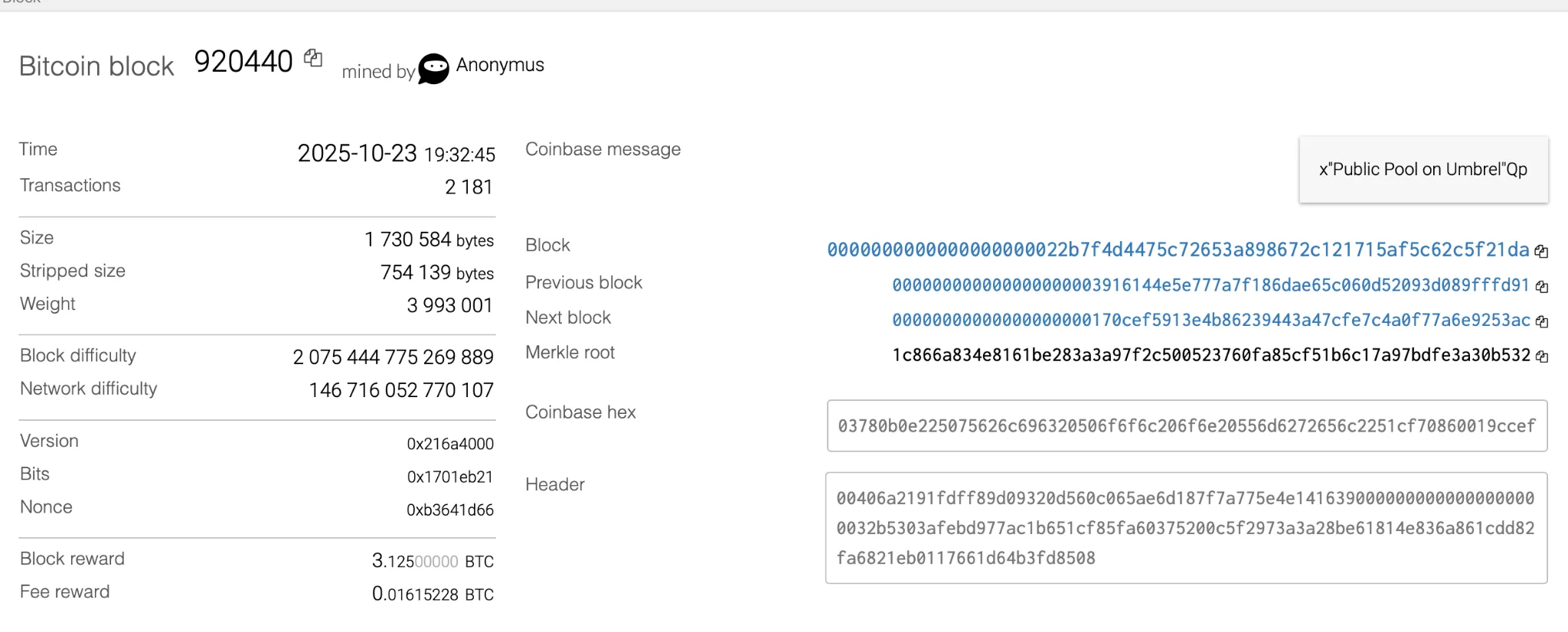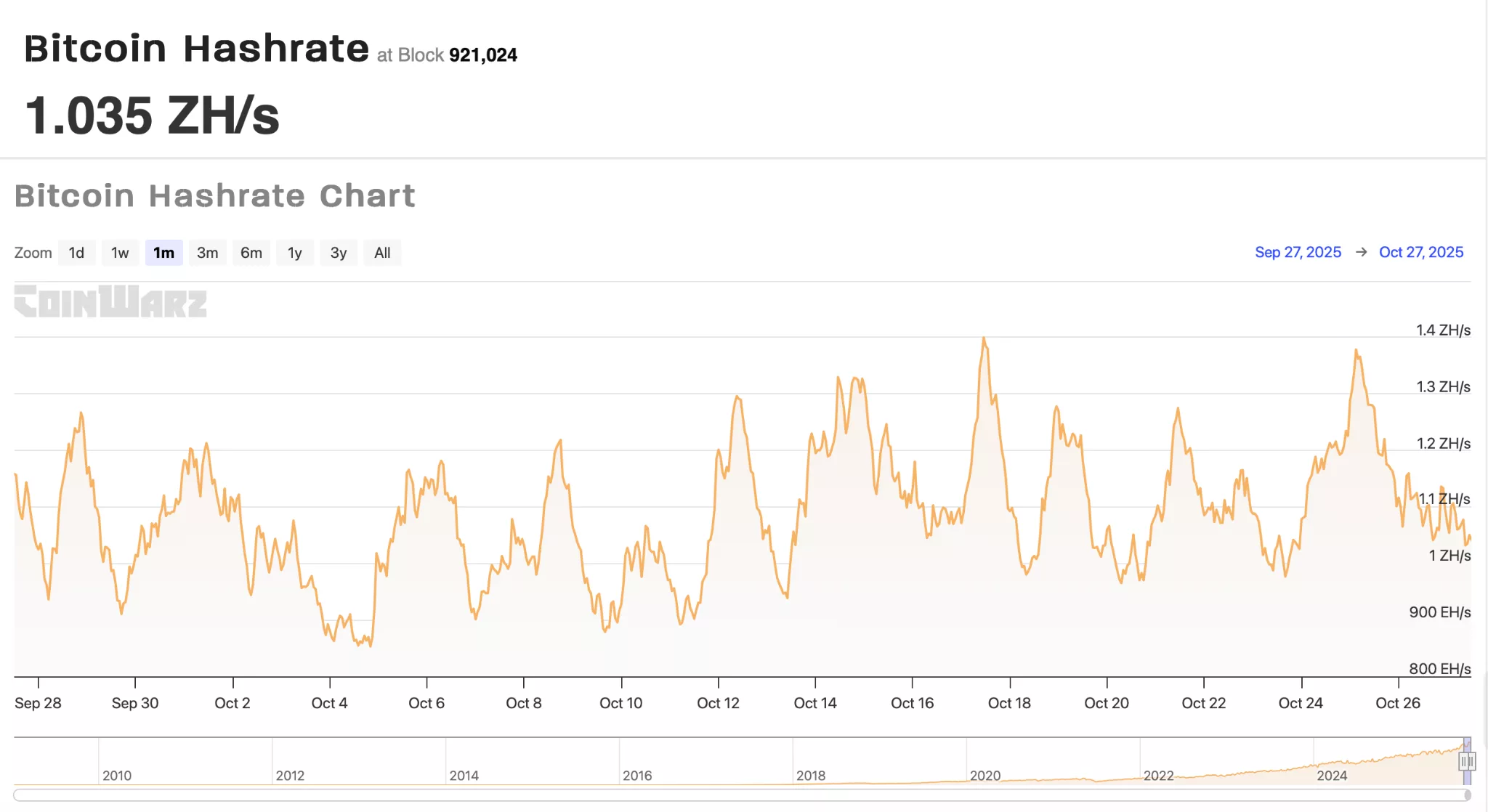How did a lone Bitcoin miner beat 1 in 10 million odds to discover a block price $347,000? And what does it reveal about solo mining in 2025?
abstract
- A Reddit consumer claimed to have independently mined Bitcoin block 920440 utilizing an Umbrel Mini and earned roughly $347,000 in rewards and charges.
- Blockchain knowledge supported this declare, displaying no hint of the proprietary Coinbase tag and enormous mining swimming pools being concerned.
- At present community ranges of greater than 1 zettahash per second, the chance {that a} single miner will discover a block is roughly 1 in 10 million.
- Industrial-scale swimming pools presently management about 75-85% of worldwide manufacturing, making standalone mining in 2025 extra of an experiment than a revenue supply.
desk of contents
Solo miner claims to have received Bitcoin in uncommon instances
A latest submit on Reddit’s r/Bitcoin group caught the eye of miners all over the world. One consumer claimed to have mined a Bitcoin block utterly on his personal with none assist from a big mining pool.
This block was numbered 920440 and included a regular reward of three.125 Bitcoin (BTC) plus transaction charges, which was equal to roughly $347,000 on the time.
Mining Bitcoin blocks entails fixing cryptographic puzzles that require huge quantities of computing energy. Every miner repeatedly checks a random quantity, generally known as a nonce, till it generates a hash that meets the community’s goal issue.
The problem stage is robotically adjusted to make sure that a brand new block is found roughly each 10 minutes, whatever the variety of competing miners. Solo miners work independently and preserve each danger and full reward, making this course of extremely unpredictable.
Presently, massive mining swimming pools dominate the community. A small dwelling miner working just a few machines will contribute just some terahashes and the chances of discovering a block are as little as 1 in 200 million.
Nonetheless, it isn’t fully unimaginable. CKPool, a platform that enables unbiased miners to work alone with out sharing rewards, has recorded some uncommon wins over the previous decade.
A Reddit consumer stated he was utilizing an Umbrel Mini system for mining and was surprised to see a “block discovered” message seem on the display screen. Neighborhood members flooded the thread with congratulations, however some urged it to be verified with blockchain knowledge earlier than celebrating.
Blockchain knowledge matches Reddit’s claims
Each Bitcoin block is publicly accessible, with precise particulars such because the time it was mined, the entity doing the mining, the problem stage, and the overall reward earned. Once we investigated block 920440, we discovered that its traits intently matched the accounts of Reddit customers.
This block was mined on October twenty third at 19:32 UTC and contained a brief textual content be aware generally known as the Coinbase tag that reads “Public Pool on Umbrel.”

On-chain knowledge for block 920440 | Supply: Bitaps
This tag, inserted by the miner’s software program, recognized the setup chargeable for producing the block and matched the Reddit consumer’s declare that it mined by a public pool on the Umbrel Mini system.
No main industrial pool makes use of that tag. Blocks mined by main operators similar to Foundry USA, F2Pool, and AntPool could have their names clearly displayed inside Coinbase messages.
The dearth of those names and the presence of customized tags means that this block was truly mined by a person quite than a pool.
Uncooked community knowledge exhibits how uncommon that occasion was. The block issue was roughly 2.07 trillion, whereas the overall community issue remained near 146 trillion.
At that stage, a house miner producing 1 terahash per second must mine for lots of of thousands and thousands of years on common earlier than discovering a block.
Nonetheless, chances can yield inconceivable outcomes. Bitcoin’s Proof-of-Work mechanism ensures that members, irrespective of how small, have a measurable likelihood of success.
There was nothing mistaken with the block itself. This included over 2,100 transactions, roughly 89% of which used SegWit, which is in line with regular community conduct.
Taken collectively, all technical indicators level to 1 conclusion. It seems that a miner working a solo Umbrel-based setup did certainly mine block 920440, defying astronomical odds.
Why solo mining is sort of unimaginable
Mining Bitcoin blocks might sound like a stage sport, however the scale at which it’s being performed at the moment tells a very totally different story. All miners within the community try to resolve the identical cryptographic puzzle, however their instruments, prices, and probabilities of success range extensively.
Residence miners often begin small. A setup might embrace one or two machines generally known as ASICs, quick for Utility-Particular Built-in Circuits.
The ASIC is constructed to carry out the one process of fixing Bitcoin’s proof-of-work equation. Every ASIC can carry out trillions of calculations per second, however even that stage of energy is tiny in comparison with the worldwide community.
As of October twenty seventh, your complete Bitcoin community is working at roughly 1.035 zettahashes per second. Which means we’re performing greater than 1 sextillion (10²¹) calculations each second.

Bitcoin Hash Fee Chart |Supply: Coinwarz
In line with one calculation, if the community stays at its present stage and runs a high ASIC producing 234 terahashes per second, the chance of discovering a block inside a 10-minute window is roughly 0.0000222%, or 2.2 in 10 million.
As a result of every ASIC consumes massive quantities of power and regularly emits warmth, miners make investments closely in cooling programs to stop {hardware} injury and preserve effectivity.
To offset these prices, miners desire areas the place renewable or surplus power is out there and electrical energy costs are very low, similar to components of Texas, Kazakhstan, and Iceland.
Carriers in these areas purchase {hardware} in bulk, typically 1000’s of items at a time, safe long-term energy contracts, and use real-time monitoring programs to handle energy masses and preserve efficiency stability.
As their operations develop, many massive miners select to mix their computing energy by mining swimming pools, the place 1000’s of members contribute assets and obtain small however regular funds, as an alternative of ready for uncommon full-block rewards.
In 2025, nearly your complete hashrate of the community will likely be concentrated in a number of massive swimming pools similar to Foundry USA, Antpool, F2Pool, and ViaBTC.
Collectively, these high 5 account for about 75-85% of worldwide block era at any given time, with smaller or unidentified swimming pools dealing with the remaining, based on knowledge from public trackers.
The function of dwelling miners is statistically negligible. In Bitcoin’s historical past, just a few hundred solo-mined blocks have been recorded, displaying how extraordinarily uncommon it’s for particular person miners to independently discover blocks.
Should you pay customary residential charges, dwelling mining isn’t worthwhile except somebody will get very fortunate and discovers a block.
Merely put, almost each block on at the moment’s networks is generated by large-scale skilled operations, however unbiased works just like the Umbrel Mini case stay uncommon exceptions.
Anybody contemplating dwelling mining in 2025 ought to deal with it as a sensible experiment quite than an funding. Whereas this gives perception into how Bitcoin stays safe and decentralized, it’s not a dependable path to earnings.










